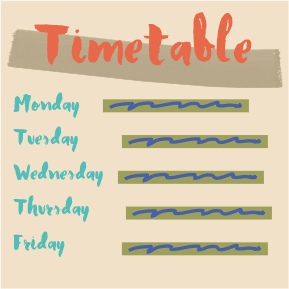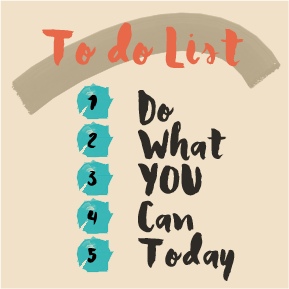Posts Tagged: print-on-demand
From someone whose done it!
Are you new to book publishing? Not sure what steps to take to ensure that your book has a chance of being seen? Unfortunately there’s no magic bullet. It’s sheer hard work once you know what to do.
After formatting your book you’re probably wondering how to make it visible. Yet long before you’ve created your book you need to have done your homework. What homework you ask? Just producing a book because you want to will not cut it. Uploading a book onto Createspace without any planning will lead to disaster.
When you’ve created your book you need to look at the whole publishing process objectively. Book production after all is a business unless you just view it as a hobby.
If you intend to make publishing your business then you’ll have to create tons of books. Very few authors have become overnight millionaires with one book!
If you’ve a passion for what you do you’re more likely to stick with it. Publishing won’t feel like hard work or a chore because you’ll love what you do.
There are plenty of platitudes and clichés when it comes to publishing but these are certainly worth considering:
Don’t reinvent the wheel.
Copy what’s already being done but do it better.
Copy what’s working
You might say ‘but I want to be original’. Go ahead, but you might not get eyeballs on your book.
So let’s not waste any more time over the pros and cons of publishing.
As you go through the five strategies you will begin to see the common sense to implementing them.
1. Niche Research and Sub-Genres
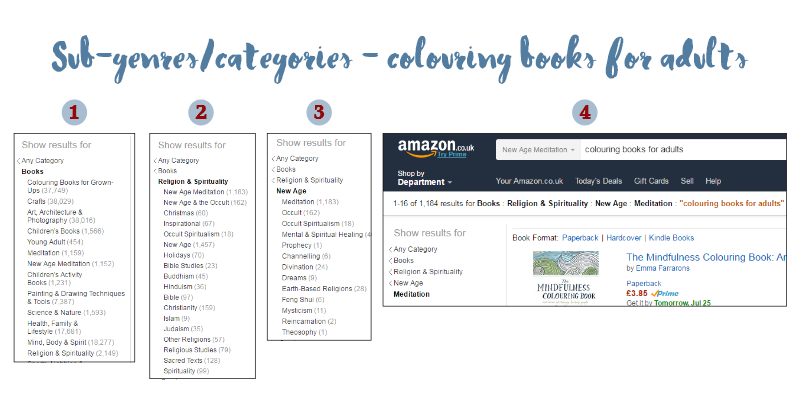
Before you do anything check out the top 100 Amazon bestsellers for fiction or non-fiction.
There are many genres and sub-genres to explore. This is the largest database of books. If you’re going to discover what works this is the place where you need to do the necessary niche research.
As an example colouring books for grown-ups peaked pre-Christmas 2015. At one point the top hundred bestsellers had over 20+ adult colouring books. It covered a variety of subjects anything from florals, gardens and animals to patterns, fashion and celebrities. An offshoot of that was the production of colouring journals referred to as zero content books. These are mostly books containing blank pages with a small area to colour.
If you’ve chosen children’s books look at the bestsellers on the first page. See the top twenty books. On 23rd July 2016 there were 10 Harry Potter books and one Harry Potter boxset. This reveals a surge in the story of Wizards. At this time it could be a skewed result as it’s the kids summer holidays. There’s no way you could beat the Harry Potter series but there are other books. David Walliams is hugely popular as is Tom Gates and Roald Dahl. Again these books have many reviews and are going to be hard to beat.
The trick is to drill down into the sub-genres where there are fewer books. If there are thousands of books it’s going to be too competitive. If it’s under 500 then the competition will be a lot lower and more accessible. A competitor’s book should ideally have few reviews which may help you to outrank theirs assuming you follow the five strategies. You’re only looking for the books in the top 100 bestsellers in any genre.
Your aim is to find books that have entered the bestsellers market with very few reviews. Explore genres and their themes. Once you’ve found a book model it.
As you research your genres take screenshots of the books and put them into a folder. Collect information on the book’s cover, title, number of pages, size of book, description, ranking in different categories. By compiling this information you will begin to familiarise yourself with the popular topics and current themes.
2. Keyword Research/Categories
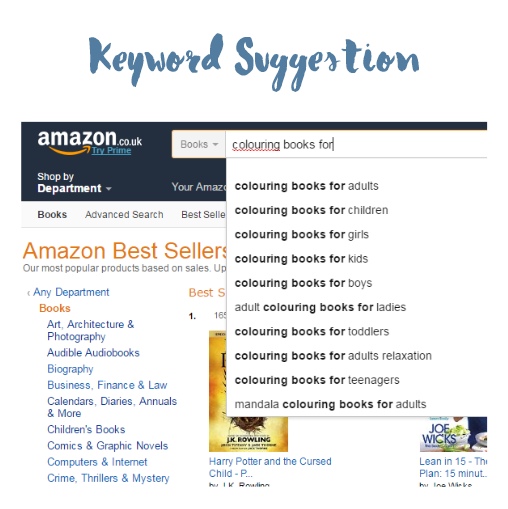
You can search on keywords which will show you what other people are searching for. This can be very helpful when deciding what genre to compete in. This technique is better for non-fiction books but can also work for fiction.
In the example above the keyword beginning with colouring comes up with keyword suggestions. The first in the list is most popular and a frequently searched for keyword phrase.
Choose another category and drill down to the sub-genres. You can see how many books are printed to the right of the category in brackets. When you get to the smaller numbers you have an opportunity to compete with the bestsellers. Once in the bestsellers you can start moving your book into other categories and testing the market.
When you upload your physical book you can have 5 keywords/Keyword phrases. Make sure that you have the appropriate keywords/keyword phrases that people search for so that your book will be picked up by the Amazon search engines. Use these keywords in your book description
Check out the authors you’ve selected to model and take note of which categories they’ve placed their books in. You’ll find this under Product Details. You can then send an email to Createspace asking them to put your books in to those categories. You are only allowed two categories.
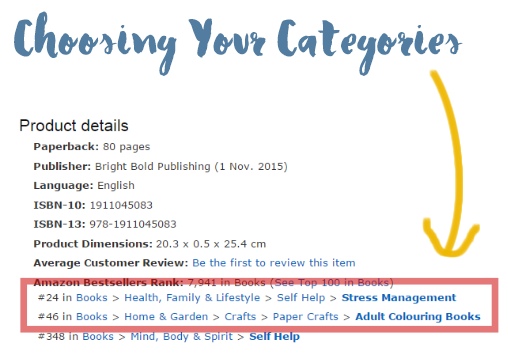
3. Produce a Series

Putting together a series is self-explanatory you’ll produce more than one book and set it up so that the covers appear to be part of a series. It’s a good idea to publish them all at the same time. This may contribute to getting you into the bestsellers.
4. Using Keywords/Keyword Phrases in Your Description
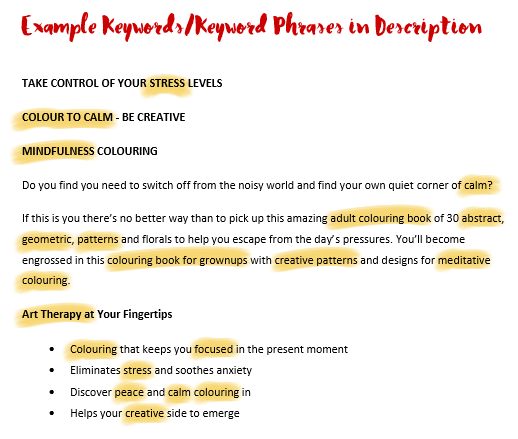
Check out descriptions your competitors are writing for their books. It’s best to find several keywords/keyword phrases that you can scatter in your text. Use them wisely so that it reads naturally. They should be in your heading, subheadings and text paragraphs.
Use simple formatting for headings and paragraphs you can apply bold, italics and bullet points. Then convert this text to html. Here’s a website you can use:
5. Brand Your Book Covers
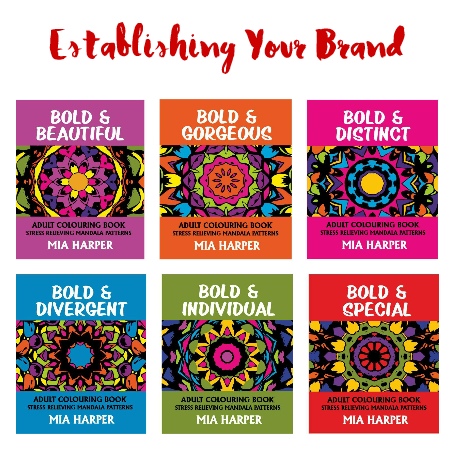
It’s really important to copy/model book covers that are already doing well in a genre. Customers’ do expect to see similar styles within their chosen genres. So to produce something totally out of character may not work.
Covers do trend in genres. What’s fashionable today might not be the case next year. So pay particular attention to the current bestseller covers. Use them as templates and adjust them slightly to produce your own brand.
Not everyone is a designer or illustrator. Today there are very cheap ways of getting covers done. You can try the following:
Final Thoughts
There are no miracles to becoming a bestseller. Here’s a reminder of the 5 strategies that may help you reach bestseller status for the short term only.
- Niche Research and Sub-Genres
- Keyword Research/Categories
- Produce a Series
- Using Keywords/Keyword Phrases in Your Description
- Brand Your Book Covers
Whilst the above strategies worked for Mia Harper’s books there are no guarantees they’ll work for you. However, with the right amount of research and work it could help boost your book rankings.
This is not the end of your book journey though. Once you’ve achieved getting bestseller status the hard work really begins. A bestseller is unsustainable without heavy promotion and plenty of reviews.
Finally, once your book drops out of the Amazon bestsellers a way to keep earning royalties is to produce more books as well as selling them on other platforms.
If you’re just starting out I hope you found these strategies useful.
If you’re already producing books do you use the 5 basic strategies outlined above?
It would be great to hear what other strategies you’re using to get your books into Amazon’s Bestsellers.
Please leave a comment that you think will help other self-publishers.
Telling it as it is – The Early Days of Self-Publishing
When I first set out to self-publish I avoided taking action because I always felt there was still more to learn.
Does this sound like you?
I had to ask myself why I was so busy without having anything to show for it.
In the early days when I was learning everything there was about publishing I suffered from overwhelm. I discovered much later that this was a common theme amongst most authors breaking into the self-publishing arena.
Arena pretty much describes the environment I found myself in; a den of conflicting advice from instructors and marketers with half-baked solutions. The challenges seemed insurmountable. I was hyperventilating, trying to fit the publishing puzzle together.
To cap it all self-publishing is a lonely, insular business which sadly can lead to depression.
Self-Publishing Anxiety
For two years I followed the internet and publishing gurus always searching for the ultimate answers which never materialised. When I spoke to other authors they nodded their heads in despair, agreeing ‘me too, me too’ confirming my own feelings that we’d all become the stooges of the so-called experts.
I purchased so many different trainings that I became more bewildered as time passed. Again this is something other authors said they were guilty of. It’s almost like I felt there was a missing link. I had to find that link before I could progress. Sadly these were all excuses. Perfectionism, my fear of not being good enough or sufficiently knowledgeable is what held me back from taking action.
Is this what you might be feeling too? Out of your depth with the whole publishing thing?
A Self-Publishing Transformation
I took one final course before I abandoned all fear of self-publishing. At the latter end of 2015 I took the necessary steps to self-publish my first set of books. Within days those books made it into the bestsellers in the UK with very few reviews and no marketing!
What pushed me over the edge to brave self-publishing you ask?
One word: PASSION.
I’d found something I felt strongly about and wanted to see it through to its bitter end. I jest there was no bitter ending just euphoria.
Discovering the Right Niche Market
The niche I’d settled on was trending dramatically. I worked like a demon to make my books happen fighting the urge to give up or fall victim to perfectionism. I was now working to my strengths.
Formatting Kindle books with pictures had proved an almighty disaster. Kindle technology was frustrating.
Previously, the idea of formatting physical books was a huge, scary hurdle.
Finding an exciting niche with all sorts of possibilities and one that allowed me to use my graphic skills propelled me into action. I was no longer afraid of the mechanics of self-publishing. I needed that extra boost in confidence one that fuelled the adrenaline.
I could say that the passion for my topic came to my rescue. I now had a reason and a why to continue.
How to Maintain the Self-Publishing Momentum
So I found my first niche and it has helped me produce books that sell.
The next obstacle was how do I keep going? How do I keep producing books in different genres? More importantly how do I stop myself from falling into the old habits of not feeling quite good enough?
It’s hard, I hear you say, to take that initial step to create a book, to continue producing further books, but once you do you won’t regret it.
For me I have to discipline myself and work to a daily plan.
Five Strategies that Promote Action
To some of you this plan may seem too simple, may even be irrelevant. It might even be missing some hard and fast components.
1. Goal Setting with a Timetable
This is a must, a way of being accountable for everything I do.
When I first started creating a timetable I didn’t allow for circumstances that could upset the whole plan. I plotted every conceivable hour without any thought for emergencies or proper breaks. The cramming in of so much was fine for a robot but not a human being.
It took me some months before I realised that I was stretching myself to impossible limits. I was unable to maintain my workload per day. I demanded too much from myself and ended up being unhappy with the lack of results.
I had to sit down and rehash the whole timetable. I added short achievable goals and long-term moveable goals. I built a plan that was flexible and adaptable one that contained the bigger picture of my goals. So far it appears to be working.
2. Creating a Daily to Do List
Every night I prepared a ‘to do list’ or reminder for the following day. This supplemented my timetable. I had to be careful that the list was feasible. I’d concentrate on the most pressing items that needed to be executed for that day. If I had to learn new skills I set aside an hour or two.
3. Learning from the Experts
It goes without saying that technology and the whole industry of marketing is changing exponentially.
As a novice in self-publishing it took me over two years to go through the swathes of people who referred to themselves as experts or an authority in marketing. I made a lot of mistakes on the way. I listened to a lot of people spouting useless information.
Most people like me were reaching fever pitch to make a living online. Notice how I avoid using the title ‘making money online’. This very idea has been the downfall of hard-working, entrepreneurs.
It’s been a difficult journey and I’ve learned lessons the hard way. I was easily distracted for all the wrong reasons. When you are in complete overwhelm and a novice your sense of judgement goes through the window. I was gullible and didn’t know any better. In my situation I bought everything because I thought I might be missing out.
If I’d only known what I know now I could have avoided the unnecessary pitfalls. So many others I know who are beginning their journey into self-publishing and marketing are saying the same thing. It is like some infectious disease.
So to avoid some of this hysteria I’ve got a very short list of marketers I will only listen to and buy from. These marketers display integrity in a market place full of charlatans.
N.B. I’m not an affiliate for any of these people.
Richard Bullivant is really the person I have to thank for my self-publishing Eureka moments. He started me on the path to self-publishing. He implemented outsourcing in his own work over three years ago. I was sceptical of utilising this method but two years later I backtracked realising it had potential.
I took a further course of his ‘How to self-publish children’s books on Kindle.’ You’ll find this course on Udemy.com, He demonstrates inspiring techniques for a variety of books.
Amy Harrop.has a natural ability to teach others with simplicity that defies complexity. I’ve always liked her style. I’ve purchased her self-publishing products of which there are too many to mention here. Check out her link:
She’s always helpful and approachable. As a publisher she’s focussed on the products which help her in her own business. As a self-publisher you’ll find lots of great tools to assist you in your book production.
David Lee Martin is an excellent trainer in Scrivener. I learnt so much from him. His pace and pitch is right for just about anyone wanting to learn how to use the software effectively. He shows you how to organise your entire book with amazing ease.
Just recently he released his ‘In the Trenches’ an invaluable volume. He informs you of his experiences in self-publishing as well as the advantages of writing in sub genres. There’s a lot of great honest insight here on how to run a successful publishing business.
Paul Coleman hints at self-publishing innovation. When I first came across him I was both amused and taken by his sense of originality. There was the element of experimental and thinking outside the box. He pulls no punches and only recommends those he feels are worthy of a mention.
Want to produce a bestseller book and find the right genre? Use Yasiv.com to assist you. It’s certainly a different approach; one worth considering.
http://www.blog.bookpumper.com/
Derek Doepker has self-publishing down to a fine art. I’ve read his ‘Hooks for Books’ a great eye opener when it comes to finding that ‘compelling’ title. He has self-publishing training courses and in his own words ‘loves sharing his experience to help other aspiring authors get their message into the world.’
http://ebookbestsellersecrets.com
Raj – of Curationsoft – is a digital marketing guru and author of “How to Build a Blog that Counts” (Amazon, 2015).
CurationSoft is the web’s premier content curation tool. You can quickly and easily build impactful and rich blog-posts, white papers, and articles consistently.
CurationSoft has built in content gathering, authoring and auto-publishing features that simplify content creation for any blogger.
Imagine following in the footsteps of Huffington Post that collects information from all over the world. With great research at your fingertips you can finesse your blogs with some inspiring ideas, optimising it with ‘authority boosting content’. It will help to draw people to your blog/website.
4. Outsourcing Work
The very thought of employing others to do my work through ‘outsourcing’ went against my principles. Of course that’s a perfectionist talking; thinking I could do everything myself.
When I heard and saw what results others were achieving over a shorter period of time I realised I needed a rethink.
Changing my ‘mindset’ was hard. There were all sorts of factors that came into play. The major one was lack of funds to implement outsourcing. I reminded myself that I was running a business which requires a budget. While creating a book is free all the other bits need some cash.
I’ll be truthful it took some time before I began to see the wisdom of outsourcing. Most, including myself, expect it to be freebies all the way! Going into self-publishing with blinkers on is a sure fire way of failing. In theory I knew it was true in practice I held onto my skewed ideals. Doing everything alone wasn’t going to cut it anymore. Not outsourcing holds you back and I was wasting so much time! Then I juggled with the concept of what kind of outsourcing I required and affordability. I’m still on a learning curve with that one! However, what little outsourcing I do execute has helped towards speeding up my production.
Some of the following outsourcing companies are worth looking at:
Upwork.com (creatives, writers, web/mobile developers, virtual assistants, etc)
Fiverr.com (illustrators, graphic design, translators, video animation, audio, etc)
iWriter.com (custom content for blogs, press releases, articles, ebooks, etc)
99Designs.co.uk (logos, branding, biz cards, packaging, t-shirts, etc)
5. Practicing Mindfulness
Finally, this is the last strategy which has brought me some peace in a noisy world of self-publishing.
I’m an advocate of living in the ‘NOW’. In essence I’m not going to beat myself up over finishing something off by the end of the day if it’s unrealistic to do so. This discipline surprisingly keeps me focussed and attentive to the task in hand. There’s no time to dwell on past failures. There’s no time to waste on future hypothetical scenarios that may never happen.
This form of therapy has brought tremendous peace and calm in what otherwise would have been a tortuous path of self-publishing.
Once I realised the sense of committing only to what was possible in a single day then things began to become easier. I won’t say that I never ever stumble but I always manage to pull myself back to the present which helps deflect the negatives.
Being and performing in the present moment is the only real action. It’s helped me face the fear of self-publishing.
What has Helped You to Take Action in Your Self Publishing Business?
What problems have you had to overcome in self-publishing?
Do you have a daily plan that works for you?
Please leave a comment that you think will help other self-publishers.
[shareaholic app="share_buttons" id="25382812"]



